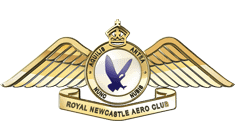
Menu

Some years earlier a visiting French pilot gave a public exhibition of flying, including a ‘death-defying’ loop the loop from Newcastle Showground. Possibly because of this and the apparent fragility of the vintage aircraft he was flying, public reaction was immediate and hostile with many regarding aircraft as out of this world, strongly opposed the sitting of an aerodrome in the city area.
For a time it appeared that the Hexham swamps would be chosen because of its flat approaches but the cost of draining and improving the swamps was found to be prohibitive.
Eventually the Club committee decided on the Broadmeadow site and club members formed working bees to clear the scrub, bush and rank grass flourishing on the land. In 1929, after the committee had drawn up its articles of association two young pilots decided to acquire an aircraft and establish an air service in Newcastle. They bought an Avro 504K the aircraft landed at Broadmeadow on September 4th 1929 did much to arouse an interest in aviation by the more adventurous minded public.
Later, the withdrawal of two aircraft promised by the government was a setback but despite this, flying training began in 1934. The Aero Club of NSW agreed to send an instructor regularly to Newcastle in an aeroplane that could be used for purposes of instructions and under this agreement flying training was inaugurated at Newcastle on April 21st 1934.
The aerodrome established, and training begun, the committee was faced with the problem of securing the funds necessary to finance the purchase of a training aircraft. It was decided that the aircraft to be purchased should be of the most modern type available. The committee’s choice fell upon the DH Moth Major. Several friends came to the aid of the Club, and their donations, together with the profits from the first Air display, enabled the purchase to be completed. This first machine, VH-URR, was delivered on October 7th 1934, and was christened ‘Mystrel’ by Mrs A Rankin.
Though the agreement with the Aero Club of NSW met the immediate need, the Committee felt that greater progress could be made if the club appointed its own instructor. Flight Lieutenant I C Thomson was selected for the position and began duty in May 1935.
In the same month the Club purchased the first DH Tiger Moth brought to Australia. This aircraft was completely equipped for instrument and inverted flying and was specially designed to be suitable for all forms of advanced flying, in addition to the ‘ab initio’ training.
The tiger, VH-UTD was delivered on June 2nd 1935, and was christened ‘Halycon’ by Mrs de Witt Batty.
Club activities continued to expand and the Club’s first fleet was further increased in 1935 by the purchase of a BA Swallow. This aircraft was delivered on September 29th 1935, and was named ‘Zephyr’ by alderman G W Jenner.
Towards the close of 1935, it was realized that the work associated with the secretarial and administrative duties was becoming too onerous for honorary officers and E A Rushbrooke, formerly a member of the committee of the Royal Aero Club of New South Wales, was selected for the position of salaried secretary. He took over his duties on February 1st 1936, and on the same day the Club’s second DH Moth Major, VH-URS was delivered. The purchase of this machine brought the total number of aircraft to four, an increase of three in eight months.
The members of the Committee had foreseen that the time was not far distant when the Club’s first hangar would prove to be incapable of housing all the Club’s machines, and plans for a large steel hangar were prepared. The construction was commenced in January 1936, and the hangar was officially opened on May 14 th 1936.
Several conferences were held between representatives of the Newcastle Aero Club and the Clarence River Aero club in 1936, and it was agreed that the Newcastle Club should be responsible for the supervision of flying training at country towns to the north and northwest of Newcastle.

